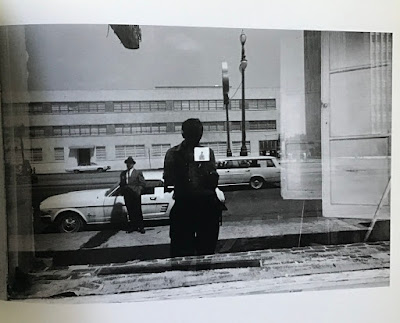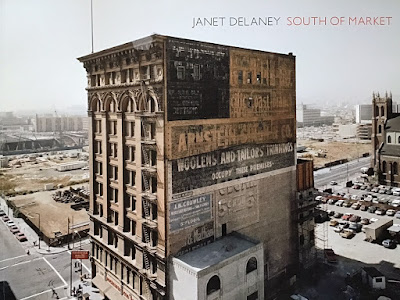Wednesday, April 29, 2020
In The Picture: Self-portraits 1958-2011
The selfie is probably the most ubiquitous use of photography today. Especially with people relegated to staying at home, many photographers seem to be doing self-portrait projects.
It seems to be a little bit of a trend that many (older?) photographers tend to be a little bit camera shy and don’t like to be photographed. I always wondered if this was due to the fact that photographers go out into the world to take pictures. I heard it described as many photographers are “Outward facing” individuals.
Personally, I’ve always disliked photos of myself. I was a little more open to the idea when I was told that a selfie implies the photo was taken by a phone and a self-portrait was taken by an actual camera. Then I saw this book:
First of all, I noticed the dates. This book spans more than 50 years. I also noticed it was a very thick book by a photographer I hold in high regard. I didn’t realize the first time I saw this book that Lee Friedlander's first book was a book of self-portraits. That much thinner volume has many photos in common with this book (I was lucky enough to find a copy a few years back). This book blew my mind of what a self-portrait could be.
The book has lots of very clever portraits using reflections. It has shadow usage as well:
And a lot more. I’m also fond of the more recent stuff, including a heart surgery.
This book made me want to take a self-portrait on every roll. More Friedlander genius, as expected.
Tuesday, April 28, 2020
South of Market
South of Market by Janet Delaney is a book about how much San Francisco, in particular the SOMA (SOuth of MArket) neighborhood is being changed by an influx of development and money. Sounds pretty typical right? Google and Twitter move in and push all the residents out.
But, here’s the twist....most of the photos in this book are from the late 1970s/early 1980s. While SOMA is being gentrified today, an earlier wave hit this working class neighborhood forty or so years ago with the construction of the Moscone Center and a promise of a “New San Francisco”.
And just like modern days, the artists lived in this working class neighborhood and were also pushed out. Janet Delaney was one of those artists and documented the transformation and death of the neighborhood with her large format camera and printed in her color darkroom in her SOMA apartment. The photos remained mainly unseen for over thirty years until the DeYoung Museum (among others) exhibited the work in the 2010s.
Janet Delaney is still shooting in SOMA as it changes. Her photos of this and protest movements in the mid-1980s (another book) are political photos without appearing to be standard news and media coverage. If art can make a difference, and be beautiful, this book is a good example.
Saturday, April 25, 2020
Leaves Turn Inside You
Leaves Turn Inside You is a recent book by another friend, Ryan Sanford. This book is in the vein of the Aure Bure Boke/Provoke school but with the twist of being in color. This book is a good example of the perks of carrying a camera everywhere and taking a picture because it feels right. This is a book of feelings. Sometimes we need photos of the world to remind us it exists and that good times exist. And also to remind us there are no rules to photography and it’s okay to enjoy not following the arbitrary rules society imposed on your camera. Thank you Ryan for letting us enjoy along with you.
Ether
Ether is a book by a longtime friend, Joe Aguirre. This book was made on a trip Joe took to Denmark a few years back. This book is full of all the things I like in a book, mysterious, odd photographs that seem both familiar and exotic. It’s even more so, in my case, because I know the photographer.
Who are these people? How did Joe meet them? These are questions I never asked him. I just chose to enjoy the book.
Monday, April 13, 2020
Sausage
Sharing one of my own photos for the first time in a while. We had an Earthquake last month here in Utah where I live. I wanted to get outside that day to relax but also to feel safe. This photo was from that day....
Head
A long time ago there was a thing called Flickr. It actually still exists and there is still a community there. But along with Flickr came the rise of the current street photography that most of us know now. There was a group on Flickr called Hardcore Street Photography, or HCSP to those in the know. The moderators of this group had very specific ideas of what street photography is. They didn't allow certain photos in the group because of their quote/unquote high standards.
Photography is full of tropes. A lot of these tropes exist for a reason. The word is photogenic. Some of these tropes will always look good. Covered cars are an easy target. I generally like photos of covered cars, even though they are cliche. One of the tropes that wasn't allowed in the HCSP group was photos of the backs of people's heads.
The current popular trend in street photography, that was popularized by HCSP, on Flickr, and now is rampant with little heart thingys on Instagram is the crowded street with someone making eye contact with the photographer. The most common argument for this is that there is a lot going on on these streets. The unfortunate truth is that there is very little going on in most of these popular photos. What is going on in these photos is a very toxic, aggressive relationship between the photographer and the people on the street. Being aggressively in someone's personal space with a wide angle lens to get the eye contact and awkward glance that makes for a good (popular) photo. Maybe I'm thinking of this because of the current social distancing state of the world but most of these photos bore the shit out of me and only make me uneasy because of the aggressive attention seeking attitude of the photographer and not the content of the photo itself.
Why am I saying all this? Because Lee Friedlander is a certified genius. He made a book called Head a few years back (with one of my favorite publishers and bonafide cool people TBW). In this book Lee shows all photos of the backs of people's heads. They all break the rules laid out by HCSP many years back on Flickr and they are all much more interesting than the street photography I've seen on that heart thingy social media app the last few years.
It's well accepted that Lee is idiosyncratic in his picture taking. This book is no exception. Every photo in this book would be an interesting New Topographic-esque social landscape but Lee has made it better by adding a person in the foreground facing away.
Subscribe to:
Posts (Atom)




























